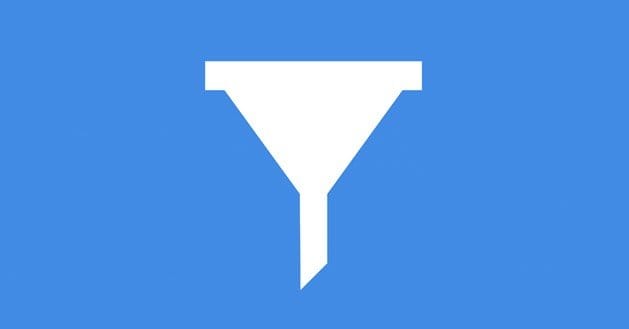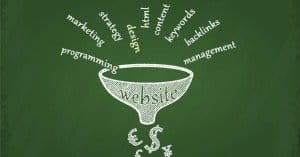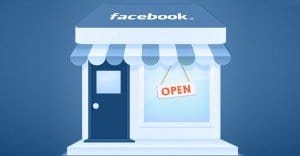 Written by ContentPowered.com
Written by ContentPowered.com
Think of Facebook like a giant pool of millions of people, all milling around, just waiting to fall into one of the many holes in the ground. Every hole leads to a funnel, which slips that person through and into a room where they are given the option to pay to go through a door and get a prize, or pay nothing to exit through another door and return to the surface. On the way down the funnel, they are shown messages about the nature of the prize.
This is more or less how establishing a sales funnel on Facebook works. You have a massive pool of people, and you try to hook them into your page. When they view your page, they are exposed to various messages, some of which are designed to push them down to the next phase of the sales funnel. Depending on how you have your funnel set up, it might be only one or two more steps before they convert.
A good sales funnel is steep, but not too steep. You don’t want to turn up the pressure and drive users away. On the other hand, you don’t want to go through too many steps before you start with the sales, otherwise you’re wasting time and money courting people who might not convert. Here’s a good example of a Facebook sales funnel, and how to implement it.
Step 1: Attract Fans
This being the first step assumes a few things. You have to have a Facebook page, and you should probably have a website. You have something to sell, and a means to sell it. With everything in place, the first part of the funnel is turning that massive pool of Facebook users in to a smaller pool of relevant Facebook fans.
The keyword here is relevant. There are a lot of ways to get a lot of Facebook fans, but most of them won’t be worth anything. Here are a few bad examples:
- You go to a site like Fiverr and buy 10,000 Facebook fans. Even if the seller claims they’re highly targeted, if they’re doing anything other than running ads on legitimate sites, they’re very likely giving you fake fans.
- You buy an overpriced piece of software that puts your Facebook account in front of clickfarm workers in Bangladesh, who like your page, then go on to like a few thousand others.
- You run a contest to give away a $500 gift card to Walmart. You get an absolutely astonishing number of new fans, all of whom could care less what your business is or what you sell. They only want the Walmart Fun Bucks.
In all of these cases, you’re hurting your funnel. See, the only people who filter down to the next step of your funnel are the people who are interested in your brand and your product. Any of the above ways of attracting fans just attracts people who don’t meet those criteria. Worse, they dilute your messages meant for interested fans. Every disinterested fan who sees your post is a lost opportunity.
There are many ways to attract relevant fans, but the easiest is to run some cheap Facebook PPC ads targeting people who like things similar to your brand and product. Spend as little as possible, as long as you’re getting quality fans out of it.
Step 2: Give Away Value
Your Facebook page should be a hub for interested users. On that hub, you definitely cannot sell your product. See, Facebook has numerous rules in place against using organic posts to try to sell your products. It’s okay to try to sell through Facebook ads, but those aren’t relevant to this particular sales funnel; they’re part of another funnel entirely.
Instead of trying to sell on your Facebook page, provide value. This value should typically be on your website, through your blog or some other landing page. Send users from Facebook to your website, and they’re able to explore and find what interests them. You can use this information to further fuel more value.
Step 3: “Sell” Value
The purpose of step 2 is to get users to recognize that you have value, by giving them a taste of that value. The purpose of this step is to provide more value, but charge an admission fee.
Now, don’t misunderstand; this isn’t the part where you sell your product. You’re not selling anything, here. You can put calls to action in your valuable information, but again, that’s a secondary sales funnel. The primary purpose of this funnel is to gather email addresses.
Why email addresses? It’s fairly easy to get people to give you their email address in exchange for something of value. It might be access to premium content, it might be more content delivered to their inbox, it might be a free ebook they’ve been told is valuable. Email addresses, then, are used in the final step of the funnel.
Don’t forget to use those email addresses in a legitimate way as well. For every direct, special offer sales message you send, you should be sending several regular newsletters. If everything is a special offer, nothing is special. Don’t fall into that trap.
Step 4: Sell, Sell, Sell
Your mailing list becomes your most direct source of contacting your fans to deliver your sales message. It’s going to be a highly personal experience, and very little advice I give will be relevant to your exact situation. Different audiences – particularly the interested segment you’ve attracted – have different needs and desires. You need to consider a number of factors.
How often are your followers seeing ads targeted at them? How often are you sending out advertorial messages? How much can you segment your mailing list to test different messages? You have a lot of options.
The goal is to use your email direct line as a way to sell your product to the most interested people out of the pool of interested people you’ve culled from Facebook at large. Craft the right message and your funnel is complete.



